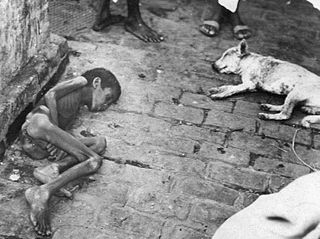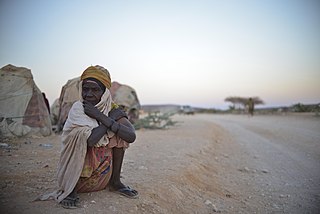
A famine is a widespread scarcity of food, caused by several factors including war, natural disasters, crop failure, population imbalance, widespread poverty, an economic catastrophe or government policies. This phenomenon is usually accompanied or followed by regional malnutrition, starvation, epidemic, and increased mortality. Every inhabited continent in the world has experienced a period of famine throughout history. In the 19th and 20th century, generally characterized Southeast and South Asia, as well as Eastern and Central Europe, in terms of having suffered most number of deaths from famine. The numbers dying from famine began to fall sharply from the 2000s. Since 2010, Africa has been the most affected continent in the world.

A widespread famine affected Ethiopia from 1983 to 1985. The worst famine to hit the country in a century, it left approximately 400,000 to 1.2 million dead. 2.5 million people were internally displaced whereas 400,000 refugees left Ethiopia. Almost 200,000 children were orphaned.

The Derg, officially the Provisional Military Administrative Council (PMAC), was the military junta that ruled present-day Ethiopia and Eritrea from 1974 to 1987, when the military leadership formally "civilianized" the administration but stayed in power until 1991.

The People's Democratic Republic of Ethiopia (PDRE) was a communist state that existed in Ethiopia and Eritrea from 1987 to 1991.
In 2006, an acute shortage of food affected the countries in the Horn of Africa, as well as northeastern Kenya. The United Nations's Food and Agriculture Organization (FAO) estimated on January 6, 2006, that more than 11 million people in these countries may be affected by an impending widespread famine, largely attributed to a severe drought, and exacerbated by military conflicts in the region.

The Ethiopian Civil War was a civil war in Ethiopia and present-day Eritrea, fought between the Ethiopian military junta known as the Derg and Ethiopian-Eritrean anti-government rebels from September 1974 to June 1991.
RRC may stand for the following:
Dolo Addo or Dolo Ado or Dollo Ado is one of the woredas in the Somali Region of Ethiopia. Part of the Liben Zone, Dolo Ado is located in the angle formed by the confluence of the Ganale Dorya with the Dawa River, and bordered to the northwest by Filtu, on the northeast by Afder Zone, on the southeast by Somalia, and on the south by Kenya. Towns in Dollo Ado include Bekol May, Dolo and Suftu. Is home to Dagoodiya
Various international and local diplomatic and humanitarian efforts in the Somali Civil War have been in effect since the conflict first began in the early 1990s. The latter include diplomatic initiatives put together by the African Union, the Arab League and the European Union, as well as humanitarian efforts led by the Office for the Coordination of Humanitarian Affairs (OCHA), UNICEF, the World Food Programme (WFP), the Puntland Maritime Police Force (PMPF) and the Somali Red Crescent Society (SRCS).
Resettlement and villagization in Ethiopia has been an issue from the late nineteenth century up to the present, due to the overcrowded population of the Ethiopian highlands. As the population of Ethiopia has increased in the twentieth century, the need to move inhabitants has only increased as available cropland per family declined to its current level of less than one hectare per farmer.

Oxfam is a British founded confederation of 21 independent charitable organizations focusing on the alleviation of global poverty, founded in 1942 and led by Oxfam International.
Between July 2011 and mid-2012, a severe drought affected the entire East African region. Said to be "the worst in 60 years", the drought caused a severe food crisis across Somalia, Djibouti, Ethiopia and Kenya that threatened the livelihood of 9.5 million people. Many refugees from southern Somalia fled to neighboring Kenya and Ethiopia, where crowded, unsanitary conditions together with severe malnutrition led to a large number of deaths. Other countries in East Africa, including Sudan, South Sudan and parts of Uganda, were also affected by a food crisis.
The South Sudan's Relief and Rehabilitation Commission (RRC) is an agency of the Government of South Sudan. It is the operational arm of the Ministry of Humanitarian Affairs and Disaster Management.

Deadly floods hit Ethiopia, leaving at least 28 people dead and over 200,000 people without a home dead as seasonal rains come early to the country. The majority of these deaths occurred in the city of Jijiga while elsewhere, heavy downpours of rain were reported with more floods expected in the next few days. The floods are reportedly at higher levels than other flood travesties than that of previous years.

The red and black coated Arado cattle are small and hardy. They are the most common cattle variety in the north Ethiopian highlands. The Arado breed is part of the Zenga breed group. It is essentially reared for draught power, particularly tillage. The breed feeds mainly on crop residues; it is adapted to seasonal feed shortages. This breed is often cross-bred through bull and artificial insemination services.
The Afar cattle are mainly found on the western margins of the Danakil Depression in Ethiopia. The Afar cattle have thick and long horns and a cervicothoracic hump; they are essentially reared for milk production.

The Abergele cattle are the smallest breed of north Ethiopia. They are reared in the Abergele lowlands and at the southwestern lower slopes of Dogu'a Tembien district. Abergelle cattle are part of the Zenga breed group. The Abergele breed is known for its adaptation to the hotter and drier lowlands. It is also very tolerant to diseases and parasites and can cope with feed shortages during long dry periods.
Begayt is an Ethiopian breed of cattle. Currently there are ongoing cross-breeding programmes with Arado cattle, in an attempt to increase the milk production of the latter.
Fogera cattle is an Ethiopian breed of cattle. One of its typical characteristics are broad hoofs, that allow it to move more easily in the marshes of the Fogera Plain. At Woreta, the agricultural research centre specialises in preserving the breed.
Sustainable Agriculture and Environmental Rehabilitation in Tigray (SAERT) was a parastatal organisation in the Tigray Region of Ethiopia. It was established in 1995 for "policymaking, design and construction of dams and canals, and the maintenance of dams and water distribution systems". SAERT was funded jointly by the United Nations Development Programme, United Nations Economic Commission for Africa and Food and Agriculture Organization of the United Nations, with the Regional Government of Tigray sharing project financing in kind.








